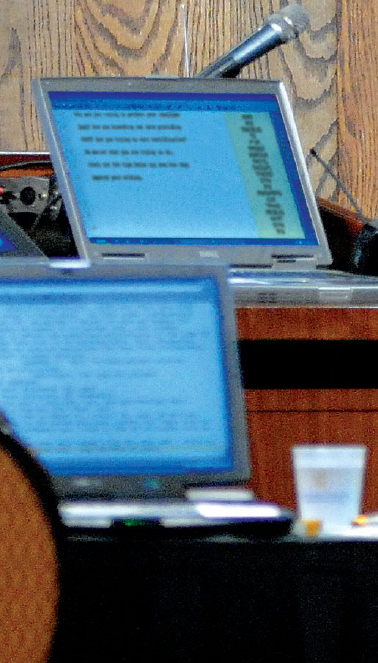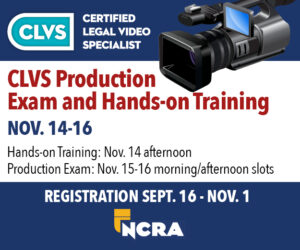Why are you trying to perfect your realtime feed? Are you branching out into providing CART? Are you trying to earn certification? No matter what you are trying to do, check out the tips below and see how they improve your writing.
TIPS FOR PASSING THE REALTIME EXAM
Barbara Tokuz, RDR, CRR, from Rockwell, Texas, gives these tips on how to pass the realtime certification test:
- Work out all of your prefixes/suffixes in your dictionary.
- Delete all conflicts from your dictionary. This will force you to find another way to write the words.
- Practice on yourself.
- Work on increasing speed with speed tapes and realtime seminars.
- Incorporate great briefs and use them regularly.
- Practice realtime on a trusted attorney or judge.
- Make sure your equipment and software is always top notch.
- Stop being scared and just do it.
- Act like a pro and be confident no matter what. No one is perfect all the time. The more you do it, the better you will be, and the nervousness will subside.
SECRETS OF REALTIME
Teri Hansen Cronenwett, RMR, CRR, who has gotten her Realtime Systems Administrator credential, is from South Jordan, Utah. She says the secret to realtime is consistent practice. Here are some of her other suggestions:
- Set up realtime at every deposition, whether they want it or not. The more you do it, the more confident you will be, and the more likely you will be to have all of your equipment at hand.
- I suggest having extra cables and extra laptops. If you have an extra laptop and the attorney can’t get his “feed” to work, you can say, “I have it working on my extra computer. I think the problem is on your end. Do you want to just use this?”
- I used to use cables. They worked every time for me, for 15 or more years (except the time my computer got dropped). Now I use CaseViewNet and a wireless router, a Cradlepoint. I love how it does the instant refresh, and you don’t have to mess with cables. The price is steep initially, but it pays for itself over time. I have also started providing captioning at church using this method.
- I usually have more than enough work because I am proficient in realtime. Not all attorneys want it and not all cases warrant it, but if you offer it, they will often ask for a rough draft, which is also an up-sell.
- As far as untranslates, the attorneys are used to it not being perfect. Just do your best! Get the caption and define some words beforehand, especially the speaker identifications, and put some briefs in that you will be using. You’ll be surprised at how nicely it does come up!
- Just work on one or two conflicts each week. Figure out a way to write each one, put up a little sticky note on your machine and go through them every day, and they will become automatic.
- As you go through each deposition, keep an eye on your untranslate rate. Compete with yourself, trying very hard to get that error rate down and write clear notes. You will love the shorter editing time!
IN THE CLASSROOM
A CART/captioner shares tips for providing realtime to hard-of-hearing clients in the classroom. Here are some ideas from her experience that may be helpful:
- I overcame nervousness by digital audio recording every lecture beginning the second semester of the first year of CART, and correcting each transcript against audio after lecture was over. I delivered a perfect transcript as if I had caught everything first crack. I recommend Olympus brand digital audio for good quality sound.
- I mark text with asterisks in realtime — in my notes, a single asterisk means to “come back and edit a mistake” (something not immediately obvious: (a) like a wrong word three lines ago that you just now understood the pronunciation of, or (b) a typo that is so close in spelling to the correct word that the eye will not see it when skimming during proofreading). I use double asterisks to mark hesitations for practice later.
- When filling in dropped segments from listening to audio recording during the first year, I used steno to type drops and copy/paste back into the transcript. Then I compiled and saved them as a file of drops and hesitations to do focused practice later on.
- Some troubleshooting tips: Since the transcript needs to be sent out after the job, some mishaps can be very frustrating. I learned after two mishaps to always ASCII rough copy immediately after the job, so at least I’d have something to work off of if anything befalls the Eclipse file. The first mishap was accidentally deleting the realtime file, but not the note file, whereupon I had to retype the whole job from readback. Another time, I accidentally deleted the whole file, realtime and notes, and had to do the entire job from audio backup. The possibility of a laptop getting stolen before you’ve sent out transcripts contained in it is also an unpleasant thought. So, emailing rough ASCII files to yourself immediately after a job is always a good precaution.
- Also, don’t be afraid to work hard. That is probably the single biggest idea that helps in the area of realtime, I think. From the beginning, back in 80 wpm, I took the advice of Phoenix Fast Track author, Carol Joachim, to focus on accuracy before speed. I agreed with that concept 100 percent and have applied it thoroughly. The result is buying back future time by investing in practice now, meaning every reduction in future clean-up time on transcripts equals more time to do whatever else. It makes the self-imposed demand of realtime perfection seem worthwhile.







